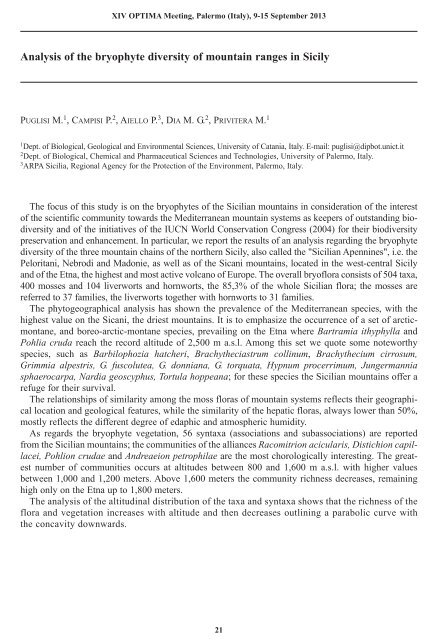Abstracts, XIV OPTIMA Meeting, Palermo (Italy) , 9-15
Abstracts, XIV OPTIMA Meeting, Palermo (Italy) , 9-15
Abstracts, XIV OPTIMA Meeting, Palermo (Italy) , 9-15
You also want an ePaper? Increase the reach of your titles
YUMPU automatically turns print PDFs into web optimized ePapers that Google loves.
<strong>XIV</strong> <strong>OPTIMA</strong> <strong>Meeting</strong>, <strong>Palermo</strong> (<strong>Italy</strong>), 9-<strong>15</strong> September 2013<br />
Analysis of the bryophyte diversity of mountain ranges in Sicily<br />
PUGLISI M. 1 , CAMPISI P. 2 , AIELLO P. 3 , DIA M. G. 2 , PRIVITERA M. 1<br />
1 Dept. of Biological, Geological and Environmental Sciences, University of Catania, <strong>Italy</strong>. E-mail: puglisi@dipbot.unict.it<br />
2 Dept. of Biological, Chemical and Pharmaceutical Sciences and Technologies, University of <strong>Palermo</strong>, <strong>Italy</strong>.<br />
3 ARPA Sicilia, Regional Agency for the Protection of the Environment, <strong>Palermo</strong>, <strong>Italy</strong>.<br />
The focus of this study is on the bryophytes of the Sicilian mountains in consideration of the interest<br />
of the scientific community towards the Mediterranean mountain systems as keepers of outstanding biodiversity<br />
and of the initiatives of the IUCN World Conservation Congress (2004) for their biodiversity<br />
preservation and enhancement. In particular, we report the results of an analysis regarding the bryophyte<br />
diversity of the three mountain chains of the northern Sicily, also called the "Sicilian Apennines", i.e. the<br />
Peloritani, Nebrodi and Madonie, as well as of the Sicani mountains, located in the west-central Sicily<br />
and of the Etna, the highest and most active volcano of Europe. The overall bryoflora consists of 504 taxa,<br />
400 mosses and 104 liverworts and hornworts, the 85,3% of the whole Sicilian flora; the mosses are<br />
referred to 37 families, the liverworts together with hornworts to 31 families.<br />
The phytogeographical analysis has shown the prevalence of the Mediterranean species, with the<br />
highest value on the Sicani, the driest mountains. It is to emphasize the occurrence of a set of arcticmontane,<br />
and boreo-arctic-montane species, prevailing on the Etna where Bartramia ithyphylla and<br />
Pohlia cruda reach the record altitude of 2,500 m a.s.l. Among this set we quote some noteworthy<br />
species, such as Barbilophozia hatcheri, Brachytheciastrum collinum, Brachythecium cirrosum,<br />
Grimmia alpestris, G. fuscolutea, G. donniana, G. torquata, Hypnum procerrimum, Jungermannia<br />
sphaerocarpa, Nardia geoscyphus, Tortula hoppeana; for these species the Sicilian mountains offer a<br />
refuge for their survival.<br />
The relationships of similarity among the moss floras of mountain systems reflects their geographical<br />
location and geological features, while the similarity of the hepatic floras, always lower than 50%,<br />
mostly reflects the different degree of edaphic and atmospheric humidity.<br />
As regards the bryophyte vegetation, 56 syntaxa (associations and subassociations) are reported<br />
from the Sicilian mountains; the communities of the alliances Racomitrion acicularis, Distichion capillacei,<br />
Pohlion crudae and Andreaeion petrophilae are the most chorologically interesting. The greatest<br />
number of communities occurs at altitudes between 800 and 1,600 m a.s.l. with higher values<br />
between 1,000 and 1,200 meters. Above 1,600 meters the community richness decreases, remaining<br />
high only on the Etna up to 1,800 meters.<br />
The analysis of the altitudinal distribution of the taxa and syntaxa shows that the richness of the<br />
flora and vegetation increases with altitude and then decreases outlining a parabolic curve with<br />
the concavity downwards.<br />
21






